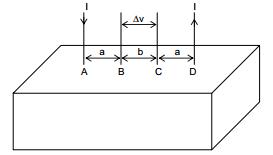Consider a block of conducting material of resistivity ‘ρ’ shown in the figure. Current ‘I’ enters at ‘A’ and leaves from ‘D’. We apply superposition principle to find voltage ‘∆V’ developed between ‘B’ and ‘C’. The calculation is done in the following steps:
(i) Take current ‘I’ entering from ‘A’ and assume it to spread over a hemispherical surface in the block.
(ii) Calculate field E(r) at distance ‘r’ from A by using Ohm’s law E = ρj, where j is the current per unit area at ‘r’.
(iii) From the ‘r’ dependence of E(r), obtain the potential V(r) at r. (iv) Repeat (i), (ii) and (iii) for current ‘I’ leaving ‘D’ and superpose results for ‘A’ and ‘D’
1. ∆V measured between B and C is
(1) ρl/ πa – ρl/π(a+b) (2) ρl/a – ρl/a+b (3) ρl/2 πa – ρl/2π(a+b) (4) ρl/2π(a –B)
2. For current entering at A, the electric field at a distance ‘r’ from A is


